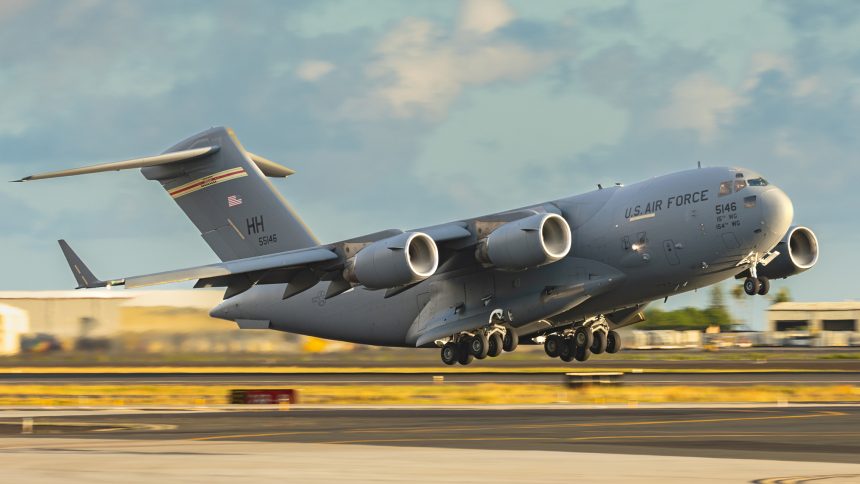In an exclusive interview at Joint Base Pearl Harbor Hickam, Col. Luke Spathes and Lt. Col. Reinier Villanueva discuss rapid mobility, integration with F-22s, and the challenges of operating in the vast Indo-Pacific.
It’s July 30, 2025, and the remote Kamchatka Peninsula in Russia has just been rattled by a massive magnitude 8.8 megathrust earthquake, the strongest quake in the region since 1952 and among the most powerful ever recorded globally. The quake triggered tsunami warnings across vast expanses of the Pacific: from Japan (where nearly two million people were evacuated), to Hawaii, the U.S. West Coast, Chile, Ecuador’s Galápagos, and French Polynesia.
In those tense hours, the 15th Wing Operations Commander immediately tasked the 535th Airlift Squadron to be ready to respond.
As soon as the reports of the earthquake and tsunami warnings reached us, my first move was to ensure our mobility forces were ready. I asked the 535th to prepare for any support mission: humanitarian relief, evacuation, or rapid deployment. “Readiness in this theater means acting immediately, before the crisis grows,” Col. Luke Spathes, Commander, 15th Operations Group.
“The moment we got the call, we pulled our crews together and checked everything: aircraft, engines, load plans, crews. The guidance to my team was simple: be ready to launch anywhere, anytime. Whether it was Hawaii, Japan, or the U.S. West Coast, we were mission-ready” Lt. Col. Reinier Villanueva, Commander, 535th Airlift Squadron.
The words above are just a chunk of a longer interview this Author had the chance to conduct in late August at Joint Base Pearl Harbor–Hickam (JBPHH). On that occasion, this Author spoke with Col. Luke Spathes, Commander of the 15th Operations Group, and Lt. Col. Reinier Villanueva, Commander of the 535th Airlift Squadron, about the role of the 15th Wing and its C-17 Globemaster III fleet.
Come along for a walkaround of a C-17 from the 535th AS / 15th Wing and get a quick look inside its massive cargo bay. Stay tuned for more from our visit to Hickam. pic.twitter.com/yiF0X6h709
— The Aviationist (@TheAviationist) September 9, 2025
The conversation explored several key themes: the unique geography of the Pacific theater; the capabilities and versatility of the C-17 Globemaster III; the integration between airlift, fighter, and tanker units on Oahu; the relationship with the Hawaiian Air National Guard; and the importance of interoperability with allies and partners.
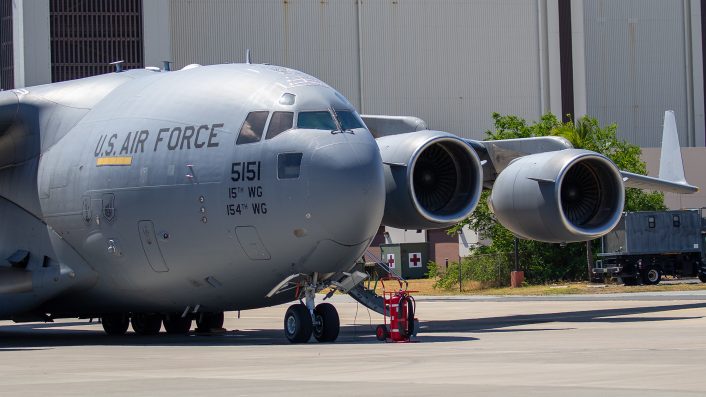
Here’s what they told The Aviationist in an exclusive interview.
Interview
The Aviationist: Could you start by introducing yourselves, with a bit about your background and experience?
Col. Spathes: I’m Colonel Luke Spathes. I’ve been in service for 23 years, and the most unique aspect of my background is probably the variety of aircraft I’ve flown—10 different weapon systems in total. These range from the F-16, KC-10, C-21, C-12, MC-12, C-17, KC-135, KC-46, and my training aircraft, the T-37 and T-1. My current role is Commander of the 15th Operations Group, which means I oversee the C-17s, C-37s, F-22s, and the 15th Operations Support Squadron.
Lt. Col. Villanueva: I’m Lieutenant Colonel Reinier Villanueva, U.S. Air Force. I’ve been serving for 17 years, with over 3,000 total flying hours, mostly in the C-17 Globemaster III. I began my career flying C-17s out of McChord Air Force Base in Washington State, then here in Hawaii, and back to McChord. I also had the privilege of doing the Mansfield Fellowship with the Government of Japan in Tokyo for two years. After that, I worked at Pacific Air Forces (PACAF), returned to the Wing, and in May of this year I took command of the 535th Airlift Squadron, where I lead 100 Airmen in missions across the theater.
Q: From your perspective as Group Commander, what role does the 535th Airlift Squadron play within the broader 15th Wing and PACAF mission?
Col. Spathes: The C-17 is one of the crown jewels of our operations. It represents rapid global mobility—it can go virtually anywhere, across vast distances, and deliver effects at the forward edge without necessarily having to land. In a theater where 50 percent of the area of responsibility is water, that kind of capability is crucial. The 535th provides that maneuver element for the entire Indo-Pacific.
Q: And specifically for the Pacific theater, with its unique distances and dispersed geography, how do the C-17s of the 535th contribute to U.S. presence and rapid response?
Col. Spathes: The squadron brings the full range of air mobility options: airland missions, humanitarian airlift, emergency evacuation, and airdrop capability. That entire portfolio is contained within a single unit.
Lt. Col. Villanueva: What makes Hawaii unique is our location. We take the responsibility of being in the Pacific very seriously. Our crews train to operate anywhere, anytime—whether it’s landing at prepared or semi-prepared fields, or performing airdrops with joint partners. The mindset is always: deliver effects anywhere, anytime, in any way.
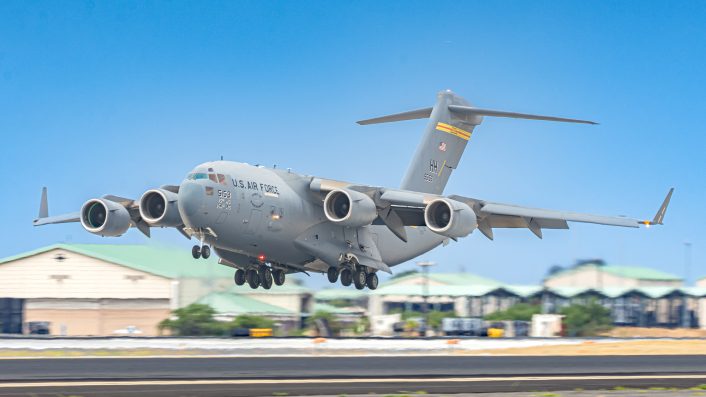
Q: The 15th Operations Group combines very different units—strategic and tactical airlift, fighters, VIP transport. Is part of your role to ensure integration across these missions?
Col. Spathes: Yes, integration is key. What we provide is decision space for commanders at every echelon, whether squadron, group, wing, or higher. Sometimes that means having units act independently, and sometimes it means combining their strengths to achieve a unified effect. The versatility of our mission set is what makes the group so valuable.
Q: Do you often integrate the F-22s with C-17s, creating composite packages?
Lt. Col. Villanueva: Absolutely. Being in Hawaii, with the Army, Navy, Marine Corps, Space Force and Air Force all present, we integrate as much as possible. That allows us to learn from each other’s tactics and procedures and ensures we’re ready to work together in future conflicts.
Col. Spathes: From the outside it may seem unusual to pair F-22s with C-17s, but in reality it’s natural. Gone are the days when airlift meant simply flying from point A to point B uncontested. In a future fight, if our lines of communication are contested, we need to pair with fighters that can protect us and ensure mission success.
Q: Do you also train defensively—using the F-22s as aggressors to test your ability to evade interception?
Lt. Col. Villanueva: It depends on the mission objectives. In some cases, escorts are essential to get us into contested airspace and achieve the mission. In other cases, we work alongside command-and-control assets and other aircraft to coordinate large formations of C-17s delivering mass effects on drop zones. We’re also unique in Hawaii in having a close relationship with the 154th Wing of the Hawaii Air National Guard, which operates the F-22s and KC-135s. We share aircraft, fly together as mixed crews, and train side by side.
Col. Spathes: Exactly. The 15th and 154th are fully integrated. What we do, we do together. It’s a force multiplier and part of our total force identity.
Q: Besides combat and deterrence, the C-17 has important humanitarian and evacuation roles. Do you also support special operations?
Col. Spathes: The short answer is yes. Our crews train for the full spectrum: conventional, humanitarian, aeromedical evacuation, and special operations support. The customer doesn’t matter; the mission does. We’ve airlifted newborns in medical emergencies from remote corners of the world, just as we’ve delivered combat forces and equipment into austere environments. The C-17’s versatility is unmatched.
Lt. Col. Villanueva: I trust any of our crews to handle whatever mission comes down—whether it’s a complex tactical airfield operation at night or a short-notice medical evacuation. For them, it’s just another Tuesday.
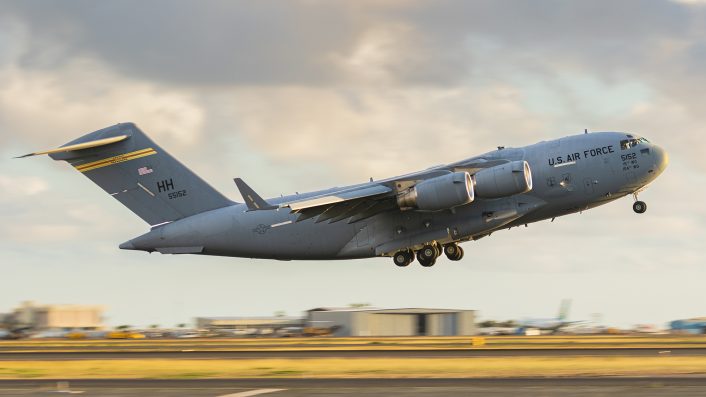
Q: While the Indo-Pacific is your main area, do you also support missions globally?
Col. Spathes: Absolutely. Our backyard is the Indo-Pacific, but we also share tasking with Air Mobility Command. That can mean flying anywhere—from Alaska to Antarctica, from the Philippines to Europe. The C-17 is a global platform, and our squadron supports worldwide missions.
Lt. Col. Villanueva: Exactly. People often assume we only operate in the Pacific, but our crews are just as likely to be tasked eastward across the globe. Whatever the requirement, we go.
Q: How do you see the role of the 535th Airlift Squadron evolving in the next decade, given the current era of great power competition?
Col. Spathes: The future is unpredictable, so we prepare for everything. The core of what the C-17 provides is decision advantage for commanders. That means training hard now, for any environment, so that when the moment comes, we’re ready. It’s not just a promise to the American people, but also to our allies and partners—we will be there.
Lt. Col. Villanueva: What won’t change is our standard of excellence. Technology evolves quickly, but what remains constant is the professionalism and adaptability of our crews. Whether in peacetime, crisis, or humanitarian relief, the 535th will always be relevant.
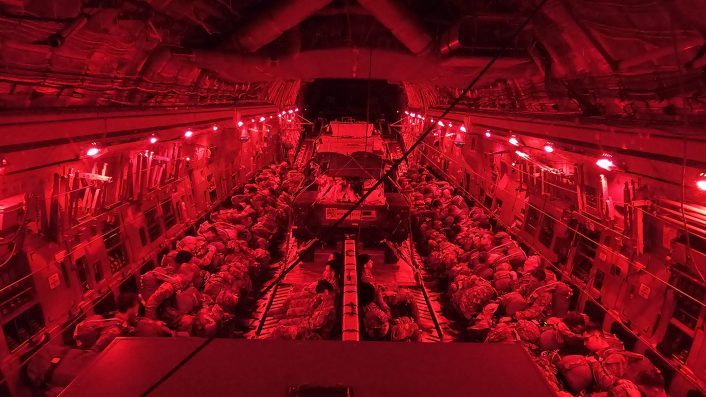
Q: Can you describe how the squadron is structured, and its relationship with the operations group?
Lt. Col. Villanueva: The 535th is about 100 Airmen, constantly rotating with new lieutenants and experienced captains. My job as commander is to ensure they and their families are cared for so they can focus on the mission. At the group level, we integrate with other commanders and units with different missions, but all with the same larger purpose: supporting our Airmen and delivering effects worldwide.
Col. Spathes: What makes the 15th unique is that we’re a composite wing, but we maintain interoperability. Any C-17 crew from anywhere—active, reserve, or guard—can join us, get in our aircraft, and immediately execute missions together. We also focus heavily on interoperability with allies and partners, as seen during exercises like Talisman Sabre, where integration extended beyond aircrews to maintenance, fuels, and logistics.
Q: Do you have exchange pilots or international integration within the squadron?
Lt. Col. Villanueva: Our squadron doesn’t have permanent exchange pilots, but the U.S. Air Force does. For example, I trained with Canadian and German personnel, and today we have U.S. pilots flying with the Royal Australian Air Force. Exercises like Global Dexterity allow us to integrate with allies such as the U.K., Canada, and Australia, sometimes even flying four-nation C-17 missions together.
Col. Spathes: And the key is interoperability, not redundancy. We don’t need one-for-one swaps of crews; we need cross-pollination, which is what these exchanges and exercises provide.
Q: The 535th was the first squadron outside the continental U.S. to operate the C-17. Has the aircraft itself evolved much since then?
Col. Spathes: The platform has continuously improved in terms of avionics and mission systems, but the fundamental strengths of the C-17 remain the same: unmatched range, payload, and versatility. In recent years we’ve also expanded into the airdrop mission set, which adds an important strategic capability for commanders.
Lt. Col. Villanueva: I first arrived at the C-17 in 2011, and while the aircraft looks the same, what has changed is how we employ it. Our tactics and planning have evolved dramatically. The professionalism and ingenuity of our aircrews have kept the aircraft relevant and lethal.
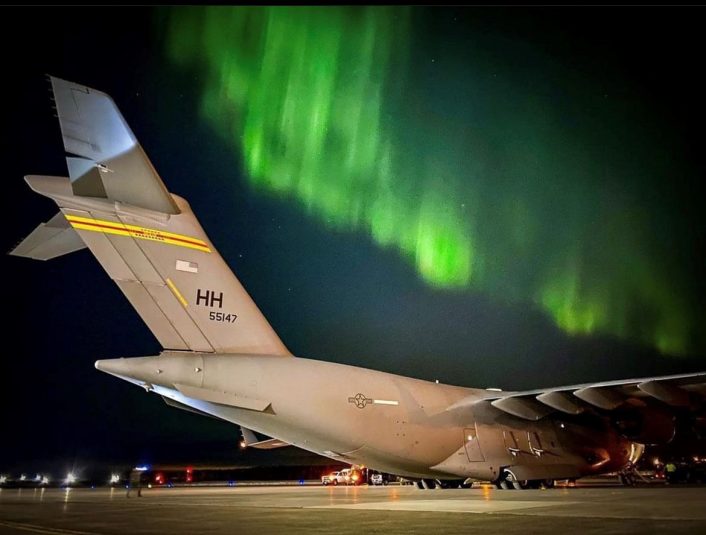
Q: In terms of missions you regularly fly from here, can you describe an average day? I know there are deployments and support to different theaters, but do you do daily low-level training? Is an average sortie around five to six hours?
Lt. Col. Villanueva: That is a great question. Missions can be anything the requirements demand, but to keep that professional edge we fly training almost every day, day and night, to keep pilots current, proficient, and continuously improving. We train alongside our Total Force partners in the 204th Airlift Squadron of the Hawaii Air National Guard, flying single-ship and formation. The portfolio includes airland to the other islands, low-level flying, air-to-air refueling, and short or simulated semi-prepared surface operations, including night landings on NVGs. That is the training envelope we work through here.
Col. Spathes: If you do not mind, I will answer your question from a slightly different angle. Across that training profile there are things you cannot truly replicate until you are doing them for real. The most noble missions are often humanitarian and disaster relief. I have to imagine that when people are at their lowest and hoping for help, hearing and seeing a C-17 arrive with responders, water, diapers, or baby formula can mean everything. We cannot rehearse the urgency and human dimension of that, but when the call comes, our crews line up to be on that flight. It is not about recognition. It is about a lineage that goes back to the Berlin Airlift. That DNA remains in our airlift squadrons. When people are in need, we show up and bring hope. That is how I would answer what an “average” day prepares us to do.
Q: You share airspace and an airport with the civilian side. How is that relationship? Is it smooth, and are there synergies? Many large U.S. air bases are purely military, whereas here the military side is part of a large international airport.
Col. Luke Spathes: With the complexity of what we do every day, some friction is natural, but it is not adversarial. From the group commander perspective, the friction tends to come from people who all care about the mission and want to get after it. Approaches may differ, but the relationship is healthy and there is willingness to come together. When we say partners and allies, that does not exclude civilian partners off base or the Hawaiian aspects of the mission. It includes the airport, the FAA, and foreign partners who fly with us. The focus shifts day to day, but there are many committed people who want to solve problems together.
Lt. Col. Villanueva: In a previous role as Chief of Safety, I regularly attended FAA meetings, visited the tower, and discussed improvements. Sometimes direct communication fades, so we create opportunities to find and remove friction points. Good relationships are key. Having each other’s numbers means we can call and work issues out. We all want safe flight operations, and that shared purpose, plus relationships, leads to great outcomes.
Col. Spathes: Like a family. Sibling rivalry can happen, but if someone messes with your little brother, the squabbling stops and the family stands together. We put those numbers in our phones not just to ask for help, but to be there when they need us. That is a real relationship. When the rubber meets the road and a call goes out from one cell phone to another, they are there because we built that trust.
Lt. Col. Villanueva: And it works both ways. When we see something happen — for example a civilian crash last year — we pick up the phone and ask what they need.
Col. Spathes: The recent tsunami is another example. In private conversations during that event, we did not know how it would develop. We were thinking about people near the epicenter, but there was also ambiguity about potential effects here. I texted Reinier to get crews ready. There could be a task coming. Get jets ready, get crews ready, and as soon as we know whether it is water, diapers, or clothes, we can respond in the Hawaiian Islands or farther away. You cannot just wait for the call. We need preparation to build the right crew pairings and ensure we have enough ready crews to respond to an ambiguous environment.
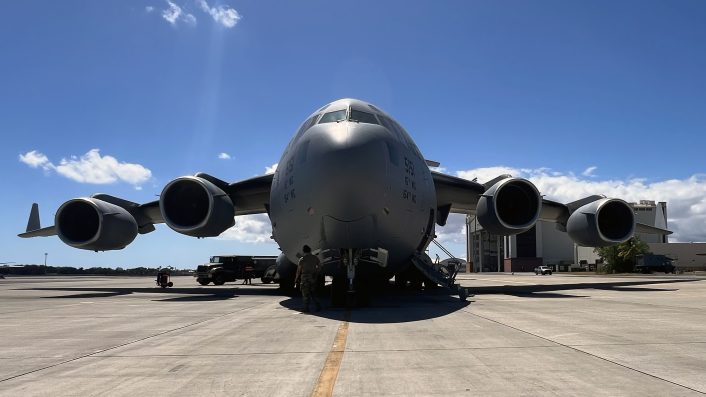
Q: Do you have plans to evacuate aircraft in case of a tsunami? Are there contingency plans that require aircraft to get airborne within specific timelines?
Col. Spathes: There are always plans to address uncertainty. In the C-17 we are ready to respond to whatever happens, and circumstances will change case by case. Do not forget the C-17 has excellent loiter time. If needed, we can take off and simply hold until the threat passes. With our Total Force Integration wing — the 15th and 154th together — we have C-17s, tankers, and fighters. If we need to clear out quickly, we take off, loiter, sustain overhead, then land when it is safe. It may not be a flashy answer, but it shows the versatility you were asking about.
Q: Last question. Is there anything I did not ask that you would like to add about the squadron or the group?
Lt. Col. Villanueva: I would emphasize the responsibility we give to young aircrews. Some are in their early twenties, a couple of years out of pilot training and four years out of college. We trust them to take a C-17 around the world and accomplish any mission. We train them to a level where they may not be able to call home or reach higher headquarters, yet we trust them to take care of the aircraft, their crews, and the mission anywhere in the world. As I get older, I am even more impressed by that. No other Air Force can match what our crews do.
Col. Luke Spathes: I would add this for your readers. When something happens, it is not one tool for one problem. It is not one C-17 and one person. There is an interconnected, interwoven relationship across this theater and across echelons of command. Are we capable of acting alone if needed? Absolutely. But that is not how we train or fight. In garrison we rely on the team, the same maturity, to solve complex problems with comprehensive solutions. This goes beyond the 15th Wing. Whether in the Pacific or Europe, there is a larger team behind every movement. We need our teammates and they need us. Our mindset is to solve the problem together.
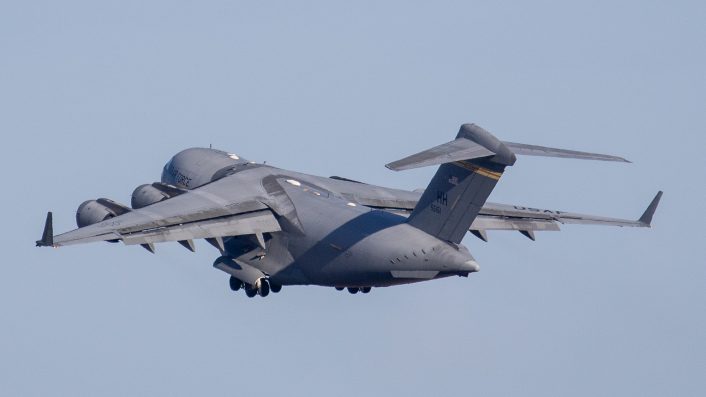
Inside the Life and Training of a C-17 Crew
Operating across the vast distances of the Pacific requires not only aircraft that can endure marathon missions but also crews that can sustain themselves through demanding schedules. As C-17 pilot Capt. Hailee Macias explained, “a big focus for us is working out and eating in a way that’s going to sustain being able to do this back to back to back. The longest mission I’ve flown lasted 28 days. We didn’t fly every single day, but during that period we were flying 24-hour missions every other day.”
Long-duration flights in the Indo-Pacific often exceed the standard crew duty day, which means missions are usually flown with augmented crews. “Whenever duty goes over 16 hours, which is almost everything out here because the Pacific is so big,” the pilot said. “We always have three pilots and two loadmasters as a minimum, and usually one flying crew chief, a maintainer who travels with us to fix problems. For a basic mission under 16 hours you’d only need two pilots and one loadmaster, but that almost never happens here.”
Rest is critical, and the C-17 is equipped with bunks that allow crews to rotate through periods of sleep. “As an unspoken rule, pilots take the bottom bunk and loadmasters sleep on the top. It’s just a handshake agreement we’ve all made,” Macias explained. Improvisation is also common on packed missions. “Some people bring hammocks and tie them in the cargo bay. Coming back from Talisman Sabre, we had so many people on board, with Army troops downstairs, that one guy just laid on the floor. But we try to use the bunks whenever we can.”
Visualizza questo post su Instagram
While helmets are not typically worn during routine flights, there are scenarios where they are required. “Normally we don’t wear helmets, but for high-altitude airdrop missions above 10,000 feet you need supplemental oxygen for the duration of the drop. In those cases we wear helmets and oxygen masks. We also wear NVGs at night. For emergencies we have quick-don oxygen masks that fit over the headset.”
A typical mission from Hawaii lasts around six hours, often with departures in the evening and returns near midnight. “Six hours is a pretty standard sortie,” the C-17 pilot said. “Sometimes we fly shorter profiles, and sometimes longer if it is a special training mission.” Unlike many U.S. bases, Hawaii lacks military training routes over land. “All of our low-level training is over water. We simulate terrain or obstacles, and at night we may fly near volcanoes on the Big Island. We also practice patterns at Kaneohe, John Rodgers, Kona, and Hilo,” the pilot noted. For realistic low-level mountain training, crews travel to Alaska on off-station trainer missions.
The C-17 is certified to fly at very low altitudes when required. “We use 300 feet above ground level as the lowest for most qualified crews,” the pilot explained. “At a 60-degree bank, our wingspan leaves just over 200 feet of clearance, so that is what has been determined safe for training.”
To fly the marathon missions across the Pacific or handle demanding low-level sorties, pilots must first complete a rigorous path of training. Becoming a C-17 pilot is a long journey. Commissioning can be achieved through Officer Training School, ROTC at civilian colleges, or the Air Force Academy. “I went through the Air Force Academy and then to Initial Flight Training in Pueblo, Colorado, flying the DA-20,” said Capt. Macias. “From there I went to Laughlin Air Force Base in Texas, flew the T-6 and T-1, earned my wings, and then went to Altus for C-17 training.” The process continues to evolve, with newer pilots sometimes bypass the T-1 and move directly from the T-6 to the C-17. Training timelines vary, but today it takes roughly eight to nine months to go from the T-6 to the C-17, followed by four to six months of C-17 qualification at Altus before joining an operational squadron.
These insights highlight not only the complexity of Pacific operations but also the demanding routine of the crews who keep the C-17 mission ready worldwide.
Acknowledgements
The author wishes to thank Col. Luke Spathes, Commander, 15th Operations Group; Lt. Col. Reinier Villanueva, Commander, 535th Airlift Squadron; and Capt. Hailee Macias, C-17 pilot, 535th AS, for their time and for answering all questions. Special thanks also go to 1st Lt. Casey E. Sturdivan, Chief of 15th Wing Public Affairs, and to the entire 15th Wing for their support before, during, and after the visit to JBPHH.
A big thank you to our contributor, Oahu-based @aeros808, for the great photographs of the C-17s operating out of Hickam.

